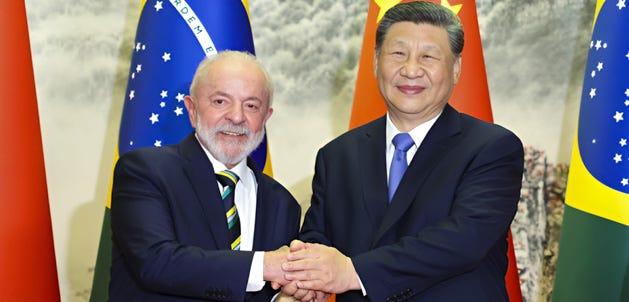Beijing’s turn to South America is redrawing agriculture trade flows and logistics chains, but on terms it can control
Making headlines at the 2024 Rio G20 Summit, Xi Jinping pledged to reshape global agri-trade. He committed to boosting PRC imports from developing countries to over US$8 trillion by 2030. In 2024, the PRC imported ~$1.4 trillion from these nations (using BRI members as a proxy). This aspirational shift, then amplified in 2025 by the tsunami of US tariffs under Trump 2.0, signalled Beijing’s intent to diversify supply and reposition PRC agri-trade ties with the Global South.
A pivot to Latin America is no surprise. Key suppliers are positioned to send more product to the PRC.
Brazil (soy, beef, corn)
Argentina (soy, beef, wheat)
Chile and Peru (fruit)
What is changing is not just volume, but the diversity of products and the deepening of PRC direct investment. New commodity approvals, infrastructure projects, and even cooperative farming ventures flag structural redirection of trade flows away from the US and toward an envisioned South–South agri-commerce axis.
Brazilian President Lula’s visit to Beijing (12–13 May) underscored this shift. It resulted in seven new agricultural agreements: more Brazilian products gained access, restrictions on soybean shipments from five Brazilian firms were lifted, and a cooperation agreement on sustainable farming practices was signed.
from Iowa to Mato Grosso
Beijing’s decoupling from US ag imports is dramatic in soy and corn. Brazil (not a BRI member state) exported some US$60 bn of agri products to the PRC in 2023, over 50 percent of its total trade with China, and 25 percent of PRC ag imports. In soybeans, Brazil supplied 75 million tonnes in 2024, 71 percent of total PRC imports—a hike from parity with the US in 2016. US market share fell to 21 percent.
The soybean recalibration has been strategic. A ban on five major Brazilian soybean exporters was lifted on 25 April ahead of the Lula visit. Customs inspections were meanwhile tightened to block beans badged as ‘US-origin’ from entry via third parties. Digital traceability using blockchain and GPS is now standard. Falsely declared ‘Argentine’ soy was re-exported in a case in February 2025.
Soybean imports fell to 17 million tonnes in Q1 2025, down 8 percent y-o-y, with a March low of 3.5 million tonnes—the lowest monthly figure since 2008. The drop reflected high domestic stocks following a record 2024 output, alongside tighter port inspections.
Over 40 Brazilian cargoes were booked for May/July delivery, with Q2 arrivals projected to reach 31.3 million tonnes. Despite seasonal substitution, concerns remain over Q4 supply. Differences in harvest timing, product quality, and shelf life mean Brazilian soy cannot fully substitute for US supply, which remains preferable on stockpiling and consistency grounds.
feed reform
A soymeal reform agenda is reshaping PRC grain demand and accelerating feed substitution. Leading producers like Muyuan Foods and New Hope are trialling formulas with lower soymeal content, making up for it with sorghum, corn, and amino acids. This supports MARA’s (Ministry of Agriculture and Rural Affairs) April 2025 plan to limit soymeal’s share in compound feed to 10 percent by 2030. This transition is expected, MARA claimed in a May policy briefing, to curb price volatility in domestic feed markets, meanwhile deepening seasonal reliance on flexible South American grain imports.
Grain imports now aim to strike a balance between state control and market response. A new so-called production-trade coordination mechanism was formalised in the 2025 No. 1 Document to ‘synchronise’ domestic output with external procurement. When harvests permit, imports are to be scaled back to avoid price collapses; when supply narrows, flows are to be eased, with no doubt a little official intervention. In Q1 2025, imports fell 41 percent y-o-y. Liu Hui 刘慧, writing in Economic Daily, hailed the drop as a strategic success that stabilised prices, improved processor margins and restored producer confidence.
expanding the trade basket
Also, realigning are corn and sorghum trade flows. A late 2024 approval of Brazilian sorghum (despite its limited export history) adds pressure on US growers, who export some 94 percent of their sorghum to the PRC. Expanding Brazil’s sorghum access offers Beijing a contingency option in the face of geopolitical risk, noted Zhou Guomei 周国梅, director of MARA’s Feed Trade Division, in a March interview.
New protocols signed during Xi’s 2024 Brazil visit had widened the trade basket to include grapes, sesame, sorghum, fishmeal and animal-feed proteins. The approval of Brazilian sorghum was an early signal of shifting preferences. Argentina, meanwhile, regained approval to export corn and wheat to China. By early 2025, Argentine exporters had signed letters of intent worth US$900 million, covering soybeans, corn, and vegetable oils. Lula's May 2025 Beijing visit saw import approvals for distillers' dried grains (an ethanol by-product used in animal feed), duck and turkey meat, poultry by-products, and peanut meal.
booming infrastructure
PRC FDI in Latin American agri-infrastructure—notably the COFCO terminal at Santos and the Chancay deepwater megaport in Peru—signals a long-term bet on upstream control. These projects are equity-led, unlike those of PRC contractors when bidding for public tenders overseas.
At Chancay, COSCO Shipping now holds a 60 percent stake in the port, which was launched by Peruvian owners, Volcan, in 2007. Though the full build-out may total US$3.5 bn, phase one investment is closer to US$1.5 bn. Some 18 metres deep, the port promises to cut shipping time to Asia by up to three weeks. Reshaping trade is aspirational for now; early consignments include palm oil, grapes, and avocados for markets other than China.
regional alignment
The implications extend beyond Peru: Chancay is to be a distribution hub for neighbouring states. Cargo redirection to Ecuador, Chile and Colombia will ease, while connecting to the Amazon Multimodal Corridor of the Northeastern Bioceanic Corridor between Brazil and Peru.
Colombia formally joined the Belt and Road Initiative in May 2025, deepening bilateral ties. President Xi hailed it as a chance to upgrade bilateral cooperation, with ag trade to benefit. BRI participation can raise bilateral ag trade by up to 35 percent, claimed the Chinese Academy of Agricultural Science in 2024, hinting that BRI accession may unlock the PRC market.
A new terminal at the Brazilian port of Santos is expected to become COFCO’s largest port facility outside China, handling 14.5 million tonnes annually—up from 4.5 million. PRC agricultural presence in Brazil now includes Syngenta (seed), COFCO (grains), Longping High-Tech (biotech), and XAG, showcasing high-performance ag drones at the 2025 Brazil Agritech Expo.
sector-by-sector footprint
PRC engagement spans the whole supply chain. Major projects include
A shift is discernible from short-term commodity deals to long-term logistics and supply chain control.
green fields, grey zones
Environmental concern over PRC demand and soybean-linked deforestation remains high. Over 230,000 ha of Brazilian forest fell to soybean expansion in 2020, mainly for export to the PRC. Links to land-use change and carbon emissions are well established.
Local tensions are meanwhile rising in Brazil. Staples like beans have become scarcer and more expensive as land is diverted toward export crops. A 2025 agreement to co-develop soy projects by Brazil’s National Agricultural Society and the PRC Hulunbuir State Farm Group reignited concerns over land ownership and food sovereignty. The deal has since drawn scrutiny from Brazilian media, with industry groups like ABRAS citing concerns about export-led monoculture expansion.
PRC regulators are stepping up their oversight of sustainability. New traceability norms are displayed in a 2025 COFCO–Mengniu–Shengmu agreement to import 1.5 million tonnes of ‘certified deforestation-free’ soy. The World Economic Forum’s Green Value Chain Taskforce certifies these deals via independently verified sourcing. PRC importers must now meet rising standards, partly driven by EU pressure, but ever more embedded in PRC regulatory practice.
Beijing urges its state-owned enterprises and private firms to adopt green standards when operating globally. Voluntary guidance issued by the Ministry of Ecology and Environment in 2017 is now subject to stricter import scrutiny. Brazil and Chile are also tightening domestic environmental controls.
flashpoint: beef and asymmetric openness
Nowhere is the tension between import access and trade restrictions more pronounced than in the beef industry. Between 2019 and 2024, production grew by less than 17 percent, while imports surged 73 percent, flooding the market. Nearly 70 percent of PRC livestock producers posted losses in 2024. Squeezed between low import prices and high feed costs, producers pushed back hard in 2024.
Tensions peaked with a March 2025 safeguard hearing on beef imports. Brazil, which supplies some 35 percent of beef imports, defended its share, citing domestic supply shortfalls and the aftermath of African swine fever; imports were a market response, not unfair competition. Import restrictions would disrupt bilateral rural employment targets, warned Uruguay and Argentina, second and third-ranking suppliers to the PRC. Chile and other lower-volume exporters requested exemptions.
Beijing responded with structural support. In Jilin and Ningxia, subsidies for frozen semen, silage, and credit, exceeding C¥19 bn stabilised margins. Processing parks and clustered slaughter zones are in train, reducing per-unit costs.
MOFCOM is expected to impose a dual-tariff quota system, targeting low-end frozen beef while maintaining access to high-end imports. This reflects a broader recalibration. US beef was hit with a 91 percent statutory tariff in April 2025, effectively shutting it out of the market. Imports fell 91 percent y-o-y in March, triggering a shortfall in mid-to-high-end supply. Premium cut prices rose by 15–20 percent. PRC producers, supported by state banks and growing consumer loyalty, have begun regaining market share.
Beijing will continue to use agricultural trade as both a carrot and a stick until tracking systems and costs align with its aims. Market access will be offered to encourage cooperation, but trade restrictions will be used as leverage when it suits strategic goals. In these unbalanced relationships, countries become dependent on PRC agricultural markets, but Beijing maintains control over the terms.
agriculture globalists
Zhang Lubiao 张路标 | CAAS Department of International Cooperation director general
PRC grain import architecture has outgrown its original design, warns Zhang. Supply risks, once cyclical, are now structural: intensifying US tensions, climate-linked volatility, and growing scrutiny of unsustainable sourcing. South America—above all Brazil and Argentina—has become China’s de facto breadbasket, but adds to exposure to concentrated corridors and foreign regulatory constraints.
Beijing must move upstream, argues Zhang. Supply security in a multipolar world means investing beyond purchase contracts into logistics, sustainability, and co-governance. This includes joint ventures in storage and smart ports, long-term offtake models, and tighter bilateral phytosanitary protocols. Without these, the PRC external food pipeline remains wide but brittle.
A champion of global engagement in agriculture, Zhang has helped reshape Beijing’s approaches to food security via external partnerships. Laying stress on long-term co-investment, he calls for sharing infrastructure, standards, and climate tech with South America. Stable agri-imports now hinge, he argues, as much on governance and logistics as on trade flows.
Zhu Ling 朱玲 | CASS member, former CASS Institute of Economics deputy director
Trade policy cannot be siloed from domestic reform, stresses Zhu. As the PRC expands its Global South trade footprint, especially in South American agriculture, it must align external sourcing with internal transformation. Brazil’s and Argentina’s cost competitiveness may otherwise further erode rural incomes at home.
Zhu urges a dual-track approach
domestically: price stabilisation, expanded insurance, and income supports for staple grain farmers
internationally: targeted diversification, forward procurement, and tighter regulatory coordination with trusted exporters
Trade, she argues, should not just fill supply gaps—it should create breathing room to modernise the PRC farming sector on more equitable and sustainable terms.
Long concerned with the structural balance of the rural economy, Zhu warns that agri-trade must be integrated into broader development. Trade, she sees, is not only an input but a lever for internal reform, pressuring inefficient production models to upgrade. The test of overseas engagement lies for Zhu in creating pathways for rural modernisation at home.








